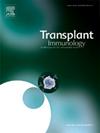Early post-lung transplant cell-free DNA levels are associated with baseline lung allograft function
IF 1.4
4区 医学
Q4 IMMUNOLOGY
引用次数: 0
Abstract
Background
Baseline lung allograft dysfunction (BLAD) is defined as the failure to achieve normal pulmonary function—specifically, forced expiratory volume in 1 s (FEV₁) and forced vital capacity (FVC) values of ≥80 %—within the first year after lung transplantation. It is hypothesised that early subclinical injury, reflected by elevated donor-derived cell-free DNA (dd-cfDNA), both in absolute concentration and percentage (dd-cfDNA%), as well as total cell-free DNA (cfDNA), may be predictive of subsequent BLAD development.
Methods
We included patients who underwent bilateral lung transplantation between May 2021 and September 2023. Blood samples collected between 3 and 9 months post-transplantation were analysed for dd-cfDNA%, dd-cfDNA concentration (copies/mL), and estimated total cfDNA (copies/mL). BLAD was defined by failure to achieve both FEV₁ and FVC ≥80 % of predicted values within the first year.
Results
A total of 158 samples from 37 patients were analysed. Ten patients (27 %) met the BLAD criteria. Those with BLAD had significantly higher dd-cfDNA levels (median: 39 cp/mL) compared to non-BLAD patients (26 cp/mL; p = 0.01). Similarly, total cfDNA levels were significantly elevated in the BLAD group (22,809 cp/mL vs. 13,840 cp/mL; p = 0.002). However, dd-cfDNA% did not differ significantly (0.23 % vs. 0.15 %; p = 0.2).
Conclusion
Elevated absolute dd-cfDNA and total cfDNA levels in the early post-transplant period were associated with BLAD, suggesting that cfDNA may serve as a potential predictive biomarker. These findings support the potential of cfDNA-based biomarkers to enhance early detection of graft dysfunction, warranting validation in larger cohorts.
早期肺移植后无细胞DNA水平与基线肺移植功能相关。
背景:基线同种异体肺移植功能障碍(BLAD)被定义为肺移植后一年内未能实现正常肺功能,特别是1 s的用力呼气量(FEV 1)和用力肺活量(FVC)值≥80 %。假设早期亚临床损伤,反映在供体来源的游离细胞DNA (dd-cfDNA)的绝对浓度和百分比(dd-cfDNA%)以及总游离细胞DNA (cfDNA)的升高,可能预测随后的BLAD发展。方法:我们纳入了2021年5月至2023年9月期间接受双侧肺移植的患者。在移植后3至9 个月采集血液样本,分析dd-cfDNA%、dd-cfDNA浓度(拷贝数/mL)和估计的总cfDNA(拷贝数/mL)。BLAD的定义是在第一年内未能达到FEV 1和FVC≥80 %的预测值。结果:共对37例患者158份标本进行了分析。10例患者(27 %)符合BLAD标准。BLAD患者的dd-cfDNA水平(中位数:39 cp/mL)明显高于非BLAD患者(26 cp/mL; = 0.01页)。同样,BLAD组总cfDNA水平显著升高(22,809 cp/mL vs. 13,840 cp/mL; = 0.002页)。然而,dd-cfDNA%没有显著差异(0.23 % vs. 0.15 %; = 0.2页)。结论:移植后早期绝对dd-cfDNA和总cfDNA水平升高与BLAD相关,提示cfDNA可能是一种潜在的预测性生物标志物。这些发现支持基于cfdna的生物标志物在增强移植物功能障碍早期检测方面的潜力,需要在更大的队列中进行验证。
本文章由计算机程序翻译,如有差异,请以英文原文为准。
求助全文
约1分钟内获得全文
求助全文
来源期刊

Transplant immunology
医学-免疫学
CiteScore
2.10
自引率
13.30%
发文量
198
审稿时长
48 days
期刊介绍:
Transplant Immunology will publish up-to-date information on all aspects of the broad field it encompasses. The journal will be directed at (basic) scientists, tissue typers, transplant physicians and surgeons, and research and data on all immunological aspects of organ-, tissue- and (haematopoietic) stem cell transplantation are of potential interest to the readers of Transplant Immunology. Original papers, Review articles and Hypotheses will be considered for publication and submitted manuscripts will be rapidly peer-reviewed and published. They will be judged on the basis of scientific merit, originality, timeliness and quality.
 求助内容:
求助内容: 应助结果提醒方式:
应助结果提醒方式:


